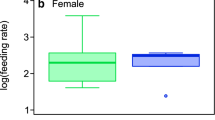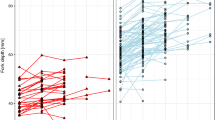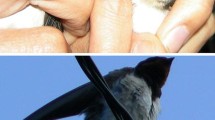Summary
The outermost tail feathers of barn swallows Hirundo rustica apparently reliably signal the quality of males, because individuals with the longest tails have the lowest degree of fluctuating asymmetry (random deviations from symmetry in the otherwise symmetrical tail trait) despite the size of their secondary sexual character. I experimentally tested whether females preferred males with symmetrical tails without altering the aerodynamic properties of birds by painting the tips of the outermost tail feathers with white or black correction fluid. Unmated males were randomly assigned to one of four treatments: (i) asymmetrical tails, where the outermost 20 mm of one tail feather was painted white and the other black; (ii) symmetrical tails where the outermost 10 mm of both tail feathers was painted white (symmetric I); (iii) symmetrical tails where the outermost 20 mm of both tail feathers was painted white (symmetric II); or (iv) controls where the outermost 20 mm of both tail feathers was painted black. The experimental treatment affected the duration of the premating period since it took longer for asymmetrical males to acquire a mate than for either group of symmetrical males or control males. This gave rise to a delayed start of laying among males with apparently asymmetrical tails. The seasonal production of fledglings therefore decreased from control males through males with either symmetrical treatment to males with the asymmetrical treatment. Females therefore pay direct attention to the level of fluctuating asymmetry in secondary sexual characters even when the asymmetry does not affect the aerodynamic properties of males.
Similar content being viewed by others
References
Balmford A, Thomas A (1992) Swallowing ornamental asymmetry. Nature 359:487
Bradbury JW, Andersson MB (1987) Sexual selection: Testing the alternatives. Wiley, Chichester
Darwin C (1871) The descent of man, and selection in relation to sex. John Murray, London
Fisher RA (1930) The genetical theory of natural selection. Clarendon, Oxford
Grafen A (1990) Sexual selection unhandicapped by the Fisher process. J Theor Biol 144:475–516
Hamilton WD, Zuk M (1982) Heritable true fitness and bright birds: A role for parasites? Science 218:384–387
Iwasa Y, Pomiankowski A, Nee S (1991) The evolution of costly mate preferences. II. The “handicap” principle. Evolution 45:1431–1442
Kirkpatrick M (1982) Sexual selection and the evolution of female choice. Evolution 36:1–12
Kirkpatrick M, Ryan MJ (1991) The evolution of mating preferences and the paradox of the lek. Nature 350:33–38
Lande R (1981) Models of speciation by sexual selection on polygenic traits. Proc Natl Acad Sci USA 78:3721–3725
Ludwig W (1932) Das Rechts-Links Problem im Tierreich und beim Menschen. Springer, Berlin
Manning JT, Hartley MA (1991) Symmetry and ornamentation are correlated in the peacock's train. Anim Behav 42:1020–1021
Møller AP (1988) Female choice selects for male sexual tail ornaments in the monogamous swallow. Nature 332:640–642
Møller AP (1990a) Fluctuating asymmetry in male sexual ornaments may reliably reveal male quality. Anim Behav 40:1185–1187
Møller AP (1990b) Male tail length and female mate choice in the monogamous swallow Hirundo rustica. Anim Behav 39: 458–465
Møller AP (1991) Sexual ornament size and the cost of fluctuating asymmetry. Proc R Soc London B 243:59–62
Møller AP (1992a) Patterns of fluctuating asymmetry in weapons: Evidence for reliable signalling of quality in beetle horns and bird spurs. Proc R Soc London B 248:199–206
Møller AP (1992b) Females prefer large and symmetrical ornaments. Nature 357:238–240
Møller AP (1992c) Sexual selection in the barn swallow (Hirundo rustica). II. Mechanisms of intersexual selection. J Evol Biol 5:603–624
Møller AP (1993) Patterns of fluctuating asymmetry in sexual ornaments predict female choice. J Evol Biol (in press)
Møller AP (1994) Symmetrical male sexual ornaments, paternal care, and offspring quality. Behav Ecol (in press)
Møller AP, Höglund J (1991) Patterns of fluctuating asymmetry in avian feather ornaments: Implications for models of sexual selection. Proc R Soc London B 245:1–5
Møller AP, Pomiankowski A (1993) Fluctuating asymmetry and sexual selection. Genetica (in press)
Pomiankowski A, Iwasa Y, Nee S (1991) The evolution of costly mate preferences. I. Fisher and biased mutation. Evolution 45:1422–1430
Stoner D (1935) Temperature and growth studies on the barn swallow. Auk 52:400–407
Thomas ALR (1992) On the aerodynamics of bird tails. Phil Trans R Soc London B (in press)
Zahavi A (1975) Mate selection — a selection for a handicap. J Theor Biol 53:205–214
Zahavi A (1977) The cost of honesty: further remarks on the handicap principle. J Theor Biol 67:603–605
Author information
Authors and Affiliations
Rights and permissions
About this article
Cite this article
Møller, A.P. Female preference for apparently symmetrical male sexual ornaments in the barn swallow Hirundo rustica . Behav Ecol Sociobiol 32, 371–376 (1993). https://doi.org/10.1007/BF00168820
Received:
Accepted:
Published:
Issue Date:
DOI: https://doi.org/10.1007/BF00168820




